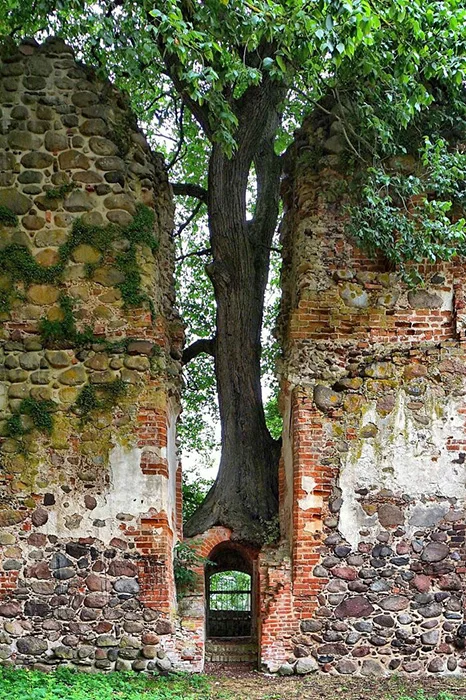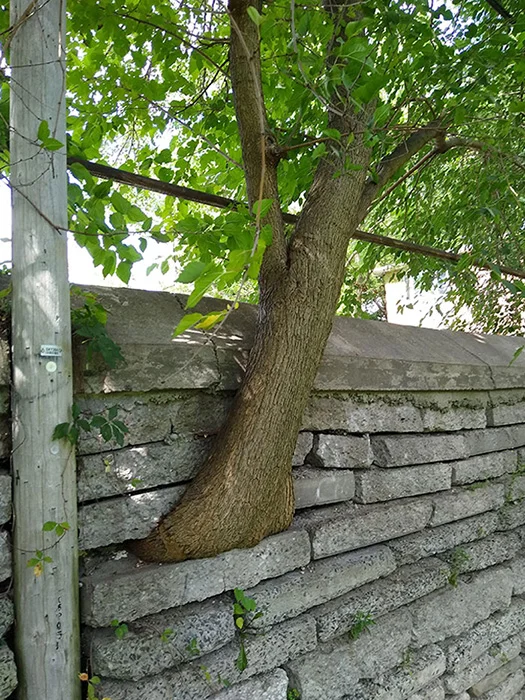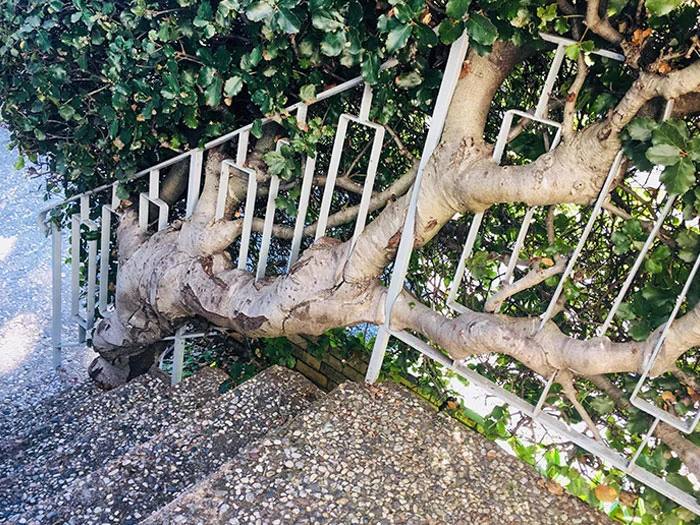People build things all the time. Houses and roads, dams and bridges, ports, factories, and entire cities at the expense of the environment. But nature is not about to give up its rightful position. On the contrary, it is determined to fight with civilization to the bitter end, proving constantly how fragile the creations of human hands are. The most interesting cases of how Mother Nature, with the passage of time, confidently reclaims its own, further in the review.
This selection contains a series of photographs that are intended to show that nature is a force to be reckoned with. After all, in the end, the world belongs to her. As much as mankind would like to think otherwise.
1 A tree that grew from an abandoned pipe 
A tree is like a hymn to life
Gatekeeper at the abandoned castle Putzar in Germany 
The building is not a hindrance.
One of the most telling examples of how nature reclaims what is rightfully hers is Tikal. It is one of the most famous remnants of the ancient mighty Mayan civilization. When writer and journalist Alan Weissman was hiking in the region, he stumbled upon something interesting along the way. Afterward, he said: "You're walking through this really dense rainforest, and you're actually walking through the hills. Archaeologists say we're all walking through ancient cities that haven't been discovered or excavated yet."
The tree found the strength to grow in this long-abandoned place 
This Chinese fishing village was abandoned in the 1990s. Nature fixed it all (Houtuwan, China) 
It's a creepy place.
The old Shiva temple is surrounded by the sacred Bodhi tree in Bangladesh 
The tree is trying to consume the temple.
The world has only become aware of places like Tikal because people have made great efforts to excavate and restore their remains. Meanwhile, countless other ruins remain safely hidden by forests and layers of soil. "It's just amazing how quickly nature can bury us," Weissman said.
There are so many pictures on the Internet that clearly show what our planet might look like if there were no humans left on it. Lately the topic has been increasingly discussed, because of the global pandemic COVID-19. After all, in many places, strict quarantine restrictions have forced people not to leave their homes. This has allowed animals to invade our quiet urban environments. Alan Weissman, even wrote a book about it, The World Without Us. The writer spent several years talking to experts and systematically developing scenarios that might unfold on our planet if we suddenly disappeared.
This tree sprouted through the sign 
The most impressive sign in the world.
Railroad tracks in the forest (Taiwan) 
I can't even believe that there used to be trains here.
In his study, Weissman began by looking at those cities where he believes the most dramatic and rapid changes would occur due to sudden human disappearance. Without the people who operate the pumps that divert stormwater and rising groundwater, the subways in huge, densely populated cities like London and New York would flood within hours of our disappearance. "Engineers told me it would take about 36 hours for the subways to completely flood," Weissman said.
Wreck recovered by nature and turned into an island 
From a ship to an island
Abandoned synagogue

Like a picture to a movie.
Without human control, failures in refineries and nuclear plants will go unnoticed. This would likely lead to massive fires, nuclear explosions, and devastating consequences as a result. "If we suddenly disappear, there will be a massive release of radiation. And that is inevitable. The consequences are almost impossible to predict," the writer explains. After our disappearance, gigantic mountains of garbage will be left behind. After all, most of the waste is plastic. It is known to persist for thousands of years, which will have a huge negative impact on wildlife.
An abandoned castle in Ireland

Nature has almost swallowed up the castle.
According to Alan Weissman, with all our polluting heritage, the water flowing underground in cities will corrode all metal structures. They support bridges, streets over underground transportation systems. As a result, entire avenues in the cities would collapse, suddenly turning into
One person came across this on a camping trip

The fabric and padding created the wet, rough surface that moss used.
Next, winter will succeed summer. Winter after winter, without all the procedures against icing, roads and sidewalks will crack. Thus, giving room for the sprouting of various vegetation. When the city streets are filled with lush, dense green growth, it will finish the process of destroying all human buildings. It will be the same with all the other buildings - in a couple of hundred years it will be unrecognizable that a man has ever set foot in these places.
Roots grow in accordance with the pattern of the pavement 
Who won: nature or civilization - a debatable question.
A tree growing through a stone wall 
I'll just get through here ...
A whole new habitat will be discovered. Nature will slowly but surely take back its territories. The former concrete jungle will become a real jungle. All this will invariably cause an accumulation of dry organic material such as leaves and branches. Fires and explosions will produce a lot of charred material. All of this will backfill the streets. They will eventually turn into small meadows and forests. This will take about five hundred years, according to experts.
Abandoned villa in Germany 
It's a sad sight
Old abandoned trails 
A place shrouded in a halo of mystery.
According to Weissman, after hundreds of years of destruction from erosion and fire, the buildings will collapse. The first to collapse will be the modern glass and metal structures. The former because they are fragile, the latter because they will be eaten by rust. Buildings made of natural materials such as wood, clay and stone will last the longest. Eventually they will become mere hills, mingling with the soil. The earth that people know so well today will disappear forever.
An oak tree growing through the railing 
To live in spite of everything.
The Earth has a chance to eventually become more vibrant and diverse. We should not forget, though, that it is now undergoing global climate change. This is probably the most indelible consequence of human influence on the planet. Weissman says it's not easy to make any predictions about how things will play out. For example, when explosions occur at industrial plants or oil or gas wells, they will continue to burn long after people are gone. Huge amounts of heat-trapping carbon dioxide will continue to be released into the atmosphere.
Become one with nature

Nature has shown who's in charge here.
Of course, carbon dioxide will not remain suspended in the atmosphere forever. The oceans will eventually absorb it. Of course, there is a limit to how much the world's oceans can absorb. After all, its own waters will oxidize to unhealthy levels. That, in turn, is enormous potential harm to thousands of marine species.
An overgrown boat that has become part of nature 
Humans have given up - nature has taken over.
A glimpse of this not-so-pretty imagined future might inspire humanity to be more mindful of its actions. Many people believe that nature would be better off without humans. But man is also an integral part of nature. It is just that, over time, people have lost the deep respect for Mother Nature that was inherent in their ancestors. Even now, a great many people try to avoid such stories about the environment. It makes them feel very bad about themselves. It is really scary to realize that people are doing such global damage to the planet. It is also unpleasant to recognize the fact that this accelerates the death of humanity itself. Environmentalists have been saying for a long time that it is time to start not only talking about this, but also doing something about it. It is not necessary to go somewhere to save the world, we can simply learn to respect nature where we live.
Read how animals return to cities that are closed for quarantine in our article



You must be logged in to post a comment.